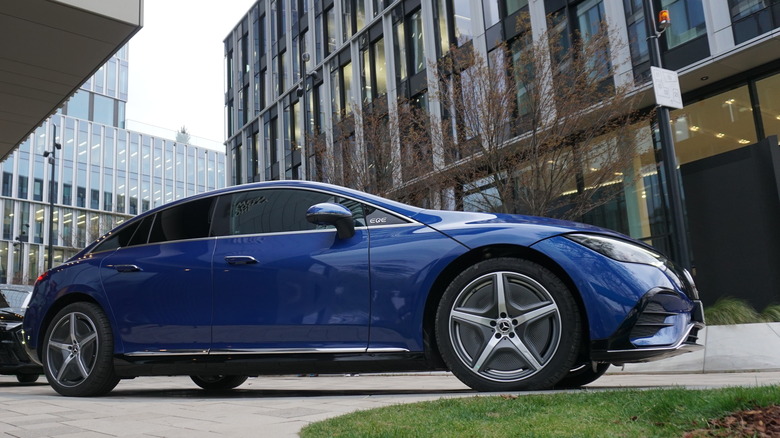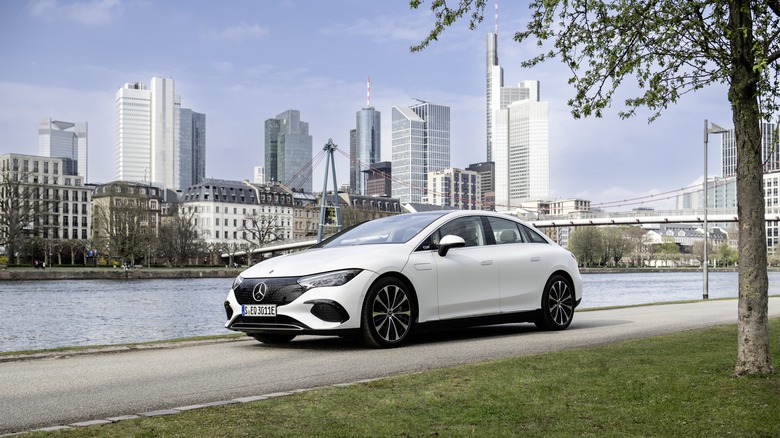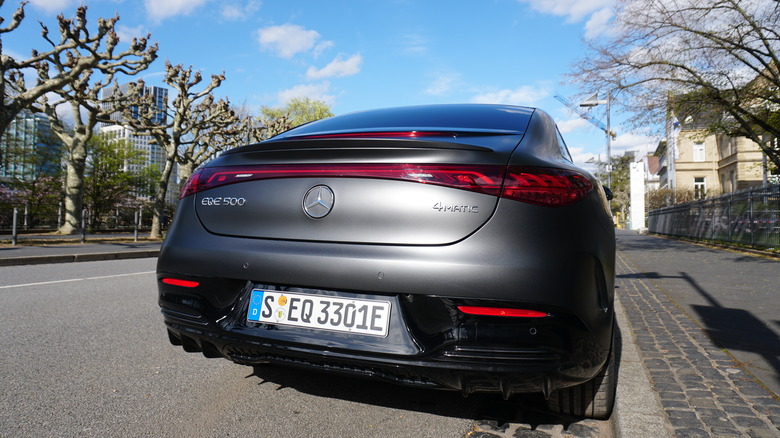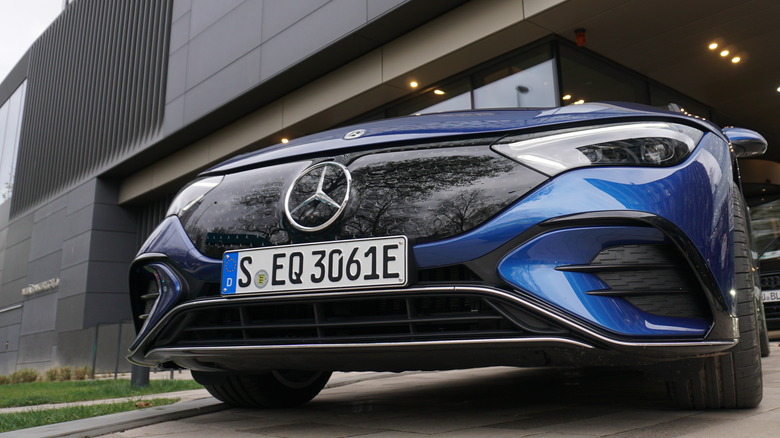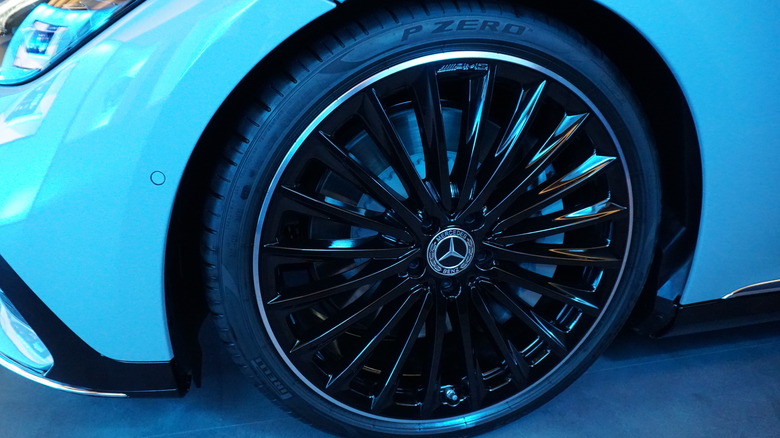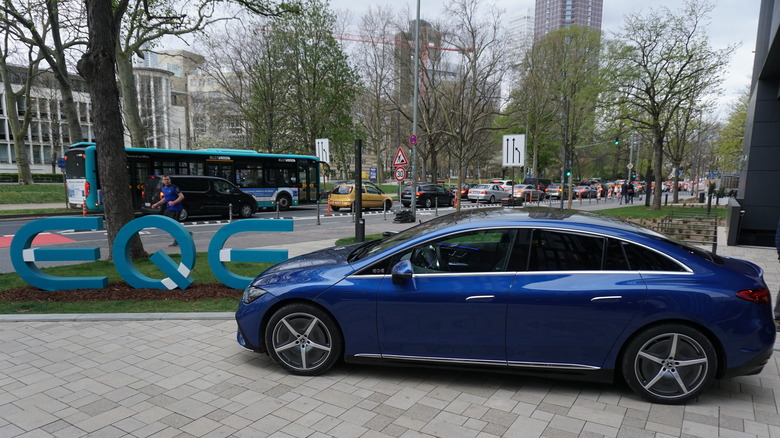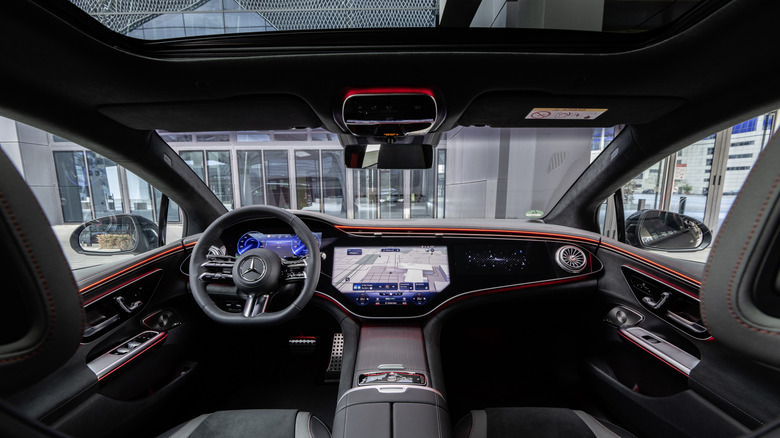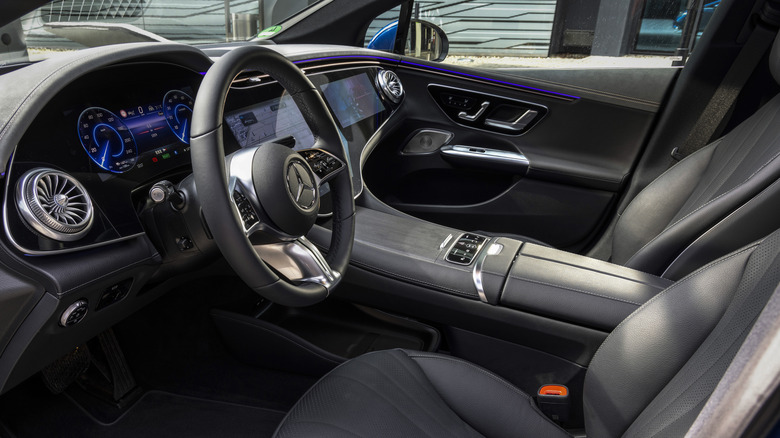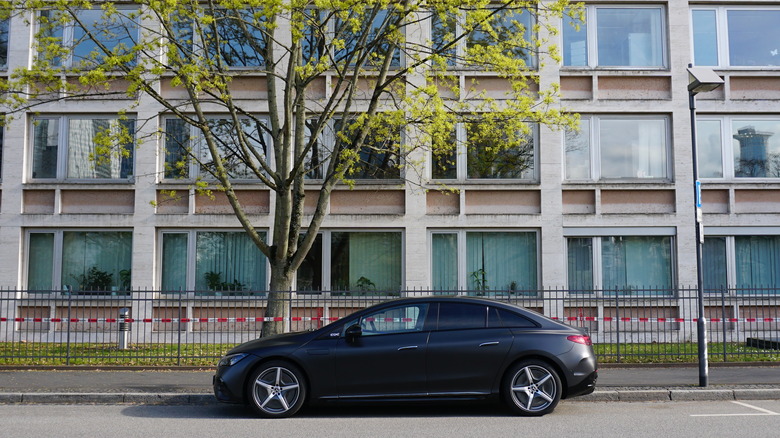2023 Mercedes-Benz EQE First Drive: More Of A Good Thing For Less
If there's an internal-combustion engine (ICE) model in the Mercedes-Benz lineup you've been yearning to snag as an all-electric vehicle, you shouldn't have to wait too much longer. The German automotive mainstay declared its intentions to make a battery EV alternative for every series in its stable by 2024 or 2025, headline of a week-long electrification media blitz in Germany and France in early April.
That's where we took first drives of both of the new EQE electric executive sedans, the 2023 EQE 350+ and the 2023 EQE 500 4MATIC, which are scheduled to hit US shores sometime in the fall of 2022. While you might consider the EQE electrics as the similarly-sized counterpart to the gas-powered E-Class sedan, they're perhaps more accurately thought of as smaller-sized versions of the electric EQS 450+ and EQS 580 4MATIC luxury sedans, which themselves are more than merely electrified S-Class cars.
After the EQS, the EQE is the second model built on Mercedes' scalable EVA2 electric platform, with further models to come this year. The EQE sedans possess more mainstream specs compared to the EQS for things like size, acceleration, battery pack and output power, horsepower, and torque. However, the EQE sedans will also have lower prices than the EQS 450+ ($102,310 base price) and EQS 580 4MATIC ($125,900 base price), which may make them more attractive Mercedes options to people considering upscale electric sedans like the Lucid Air ($77,400 base) or the BMW i4 ($55,400 base). Final US pricing for the EQE sedan should be announced later this year.
A lighter touch
The EQE retains the "one-bow," cab-forward design of the EQS with its body made up mostly of a variety of steel grades, as well as lightweighting aluminum for the doors, hood, trunk lid, and front fenders. Mercedes put a heavy emphasis on aerodynamics for energy efficiency. The larger EQS has a low drag coefficient of only 0.2 though, while the EQE drag coefficient has not been released yet, it should be some degree higher because of certain design constraints such as shorter front and rear overhangs.
At 196.6 inches long with a 122.8-inch wheelbase, the EQE is several inches shorter on both counts than the EQS, but it is the same height and width. As such, the cabin doesn't suffer in spaciousness. Settling into the driver's seat and finding its perfect height and depth from the in-door, 4-way adjustable seat controls felt relaxing and supportive over a 90-minute drive in the EQE 350+.
The car is also very well sealed and protected against wind noise, so the ride was either remarkably quiet when we wanted it or else there was minimal to no noise interference with the standard Burmester sound system. Listening to German nu-disco music from the local radio sounded crystal clear and defined as if sitting in a well-tuned living room, although SiriusXM satellite radio also comes standard.
Subtle power
It also helped that the test vehicles came equipped with many of the optional add-ons such as the AIRMATIC air suspension, upgraded from the standard steel suspension. Although we were hard-pressed to find many rough roads to tax the suspension along the test drive routes that took us through the inner city of Frankfurt and the Autobahn, country roads, and suburbs of the surrounding area, both EQE models fairly glided their way through some very smooth rides.
However, the two EQE versions do feel somewhat different to pilot. The EQE 350+ has a single rear-axle, 215 kW motor producing 288 horsepower and 391 pound-feet of torque. On the other hand, the EQE 500 4MATIC's pair of front- and rear-axle motors combine for 300 kW of output power and 402 horsepower, with torque numbers yet to be announced. It also derives its moniker from its fully-variable 4MATIC all-wheel drive with torque shift.
The most immediately noticeable difference when driving the two cars comes from the acceleration, which is estimated at 0 to 60 mph in 6.2 seconds for the EQE 350+ and 0 to 60 mph in 5.2 seconds for the EQE 500 4MATIC. But what a difference that one second makes. It feels like a much more drastic pop in the all-wheel drive car, whether flooring it from a complete stop or just punching the speed up by a quick 20 mph from a casual press on the accelerator.
Not hard to handle
The EQE 350+ possesses some heft too. During a rare break in traffic on the Autobahn with enough straightaway to let loose, we quickly revved it up to 167 kmh (103.8 mph) before needing to exit. We never had a chance to open up to 130 mph, the EQE's top speed, an electronically limited maximum.
If you go overboard with the pick-up, both the EQE's responsive steering and brakes inspire confidence, and there is Active Brake Assist as standard. The optional Driver Assistance Systems package also tacks on many braking and steering helpers, such as Emergency Stop, Lane Keeping, and Cross Traffic functions.
Rear-axle steering is also available as an option. This improves handling and maneuverability at slower speeds by allowing the EQE to corner like a compact car. Rear-axle steering angles up to 4.5 or 10 degrees combine with a more direct front-axle steering ratio and integrated actuation of the steering and brakes.
Wherever will it roam?
The EQE's power, torque, and acceleration numbers are all lower than the EQS specs, in part to save energy draw from the smaller battery pack, which is 90.6 kWh in the EQE, compared to 107.8 kWh in the EQS. We never needed to recharge during our test drives. However, Mercedes lists EQE recharging capability at 9.5 hours to top up from 10 to 100 percent from a Level 2 wall charger, or 32 minutes to go from 10% to 80% using DC Fast Charging at 170 kW.
While Mercedes has also quoted 660 km (410 miles) of electric range for both EQE versions based on European WLTP test cycles, the EPA estimates are not available yet. It's worth noting that the EPA's testing tends to be more pessimistic. For the EQS, for example, while the WLTP estimated as much as 478 miles, the EPA clocked the EQS 450+ at a still-respectable 350 miles and the EQS 580+ 4MATIC at 340 miles of range.
The road to recovery
If you're concerned about range, or just striving for efficiency, you can recapture energy for the battery via a choice of four regenerative braking modes, selectable from paddles behind the steering wheel. The lightest touch sees the EQE sedan coast in traditional fashion with no regenerative braking, above which there are three levels of standard recuperation and finally the Intelligent Recuperation mode.
The latter option actually incorporates sensor input from the navigation and driver assist functions for what amounts to a semi-autonomous experience, albeit if all the conditions are right. For example, with Intelligent Recuperation activated during a long, downhill stretch full of curves, we let off of the pedals entirely, and the system managed the regenerative braking to take into account the distance from the nearest vehicle, the speed going into a curve, and the speed relative to the current speed limit. The results were smooth and safe. All we had to do was steer until it was time to accelerate again.
As fun as that was on open roads, during busy city driving the Intelligent Recuperation became obtrusive, trying to take over too liberally when making turns and rolling through traffic lights. But no worries; switching to a standard regen mode felt more natural and let us coast almost to a complete stop before having to brake ourselves.
At home on the go
Inside the EQE, it's almost like a high-end hotel room on wheels. As standard, you get plenty of natural light from the panoramic sunroof, 64-color ambient lighting, a smartphone compartment with wireless charging and USB-C ports, turbine-style air vents, and soothing Neotex (EQE 350+) or leather (EQE 500 4MATIC) seats with heating and ventilation (and, optionally, massage).
The latest-generation MBUX infotainment system stands out as the centerpiece. Our EQE 350+ test vehicle had the standard display scheme, comprising a 12.3-inch instrument cluster and a 12.8-inch center OLED pressure-sensing touchscreen. Display layouts are configurable, for example to show the navigation map from the front cluster, and you control the system from touch-sensitive steering wheel controls, the center touchscreen, or the row of function buttons below it.
This standard setup felt adequate for the first drive. However, the test EQE 500 4MATIC had the optional 56-inch Hyperscreen, a collection of three OLED displays covered with a single, dashboard-wide glass fascia: the 12.3-inch instrument cluster, a 12.3-inch passenger display, and a larger 17.7-inch center display. The Hyperscreen supplants the function buttons, but we quickly got used to asking the standard voice assistant things like, "hey Mercedes, turn the volume up," or "hey Mercedes, make it colder in here." It responds fairly well to natural language. A real highlight of having a significantly larger center screen is being able to see the camera views around the car, with enough remaining space to show a helpful navigation map.
We like our reality augmented
The optional features that simultaneously feel the most helpful for everyday driving while also feeling like operating a futuristic spacecraft are the combination of the augmented reality camera view for navigation, and the head-up display that appears on the windshield.
The former innovation overlays dynamically changing directional arrows onto the camera views onscreen, to show your next navigational move. The head-up display, meanwhile, efficiently packs a plethora of the most important information for your drive onto a small but very legible view. It's configurable to include the a small nav map with the next move, the distance to the next move, distance and time to destination, current speed, and a super helpful speed-limit icon that flashes if you get into the speeding violation danger zone.
While the simple existence of these combined displays themselves isn't mind-blowing, the experience of using them in tandem—especially if it's the first time—feels so advanced over just using a GPS map that for a moment it seemed to be a distraction. In reality though, it quickly became very natural and presented a comforting higher level of control.
The brave new world of the same old benchmark
With Mercedes-Benz pushing to electrify every segment in its product line in the near term, the new EQE does not push the boundaries of the company's EV offerings much further than the EQS did a year ago. Rather, when it comes to the US market in the fall of 2022, the EQE will present drivers the opportunity to benefit from Mercedes' comprehensive technological advancements and luxury design that it debuted with the EQS, but in a package likely to fall a notch or more below the six-figure mark.
The EQE's perks include some pedestrian but important thinks like integrating Spotify, Amazon Music, Apple Music steaming. And they extend to more exotic options like the Energizing Air Control Plus upgrade that incorporates a front-hood HEPA filter and cabin filter with activated carbon coating for reducing odors and airborne pollutants. After this test drive, executives emphasized that much more is to come from Mercedes' new Electric Software Hub in Germany that integrates software development from around the world into its vehicles.
Yet the bottom line is that this electric executive sedan is what Mercedes-Benz always intends: a combination luxury and performance car that's as familiar in spirit as the EQE is unique in execution. If the pricing is right, that sounds like just what the market has been waiting for.
